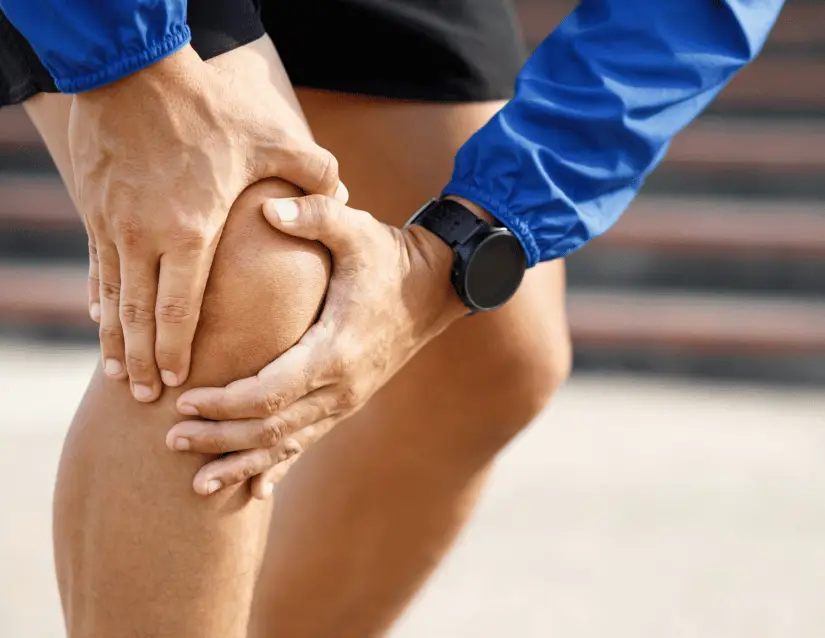Knee osteoarthritis rehab is in high demand because knee arthritis is a massive problem. The average person has a 45% chance of getting painful knee osteoarthritis in at least one knee (Farrokhi 2013).
Since it’s such a prevalent problem, knee arthritis is big business.
Sadly, some companies push ineffective treatments and publish misleading content in order to sell expensive interventions and profit off knee pain.
There’s a lot of bad information out there. But fear not, you are about to become enlightened (about knee pain, at least).
Here’s what science really says about knee osteoarthritis:
Risky Business
Osteoarthritis, the most common type of arthritis, affects a single joint. It’s characterized by cartilage breakdown and inflammation in the affected joint.
In contrast, conditions like rheumatoid arthritis and psoriatic arthritis cause systemic inflammation, leading to pain in multiple joints at once.

Not everyone gets knee osteoarthritis (OA). 4 risk factors elevate your odds of getting knee OA.
The biggest risk factors for knee osteoarthritis are:
- Quadriceps weakness
- Obesity
- Older age
- History of knee injury
It’s important to distinguish between modifiable risk factors and non-modifiable risk factors. The first 2 risk factors are modifiable – within your sphere of influence.
Unfortunately, most of us don’t have the power to reverse time or undo a previous knee injury (risk factors 3 and 4).
What Does Knee Arthritis Feel Like?
Usually nothing.
You read that right.
Most knee arthritis is pain-free.
More on that subject in the next section.
When knee OA is symptomatic, characteristics include morning stiffness, swelling, crepitus and restricted range of motion.
How is Knee OA Diagnosed?
Here’s where it gets tricky. Remember how I said most knee OA is asymptomatic?
As few as 15% of people with knee arthritis on X-rays actually experience pain (Bedson 2008). Researchers found a poor correlation between knee pain and X-ray findings.
X-rays play a role in diagnosis, but tell-tale symptoms (like stiffness and swelling) guide clinicians to an accurate diagnosis.
In other words, if it walks like a duck and sounds like a duck, it’s probably knee arthritis.

The First Line
The top 3 knee osteoarthritis rehab treatments are:
1. Exercise
Guidelines support various forms of exercise, including resistance training, walking, Tai Chi, and aquatic exercise. Learn more about the best low-impact exercises for bad knees. Plus, how to create a cardio habit the easy way.
Knee osteoarthritis rehab experts recommend respecting pain but not avoiding it, because arthritic pain during movement is almost never causing damage. Plus, exercise is healthy for achy joints, making them more robust and resilient.
2. Patient Education
The best physios lean heavily on education during knee osteoarthritis rehab. These clinicians help their patients understand knee arthritis, provide reassurance, and develop a collaborative recovery plan customized to their clients’ needs.
3. Weight Management
Obesity is a major risk factor for developing knee OA. Working towards (or maintaining) a healthy body weight reduces knee OA pain and promotes whole-body health.
First Line Failure
Unfortunately, only 40% of individuals with symptomatic knee OA receive these 3 critical treatments (Dantas 2021). Instead, many endure unproven treatments or resign themselves to living with knee pain.
Knee osteoarthritis rehab with a physical therapist is the best way to treat most knee OA, along with weight management. Steroid injections and anti-inflammatories also aid in pain management.
Contrary to popular belief, most knee OA does not lead to a knee replacement. Joint replacement is a reasonable last resort if knee pain dramatically deteriorates quality of life.

Avoid These for Knee OA
Guidelines recommend against opioids, gel injections (visco-supplementation) and most supplements because they lack scientific support.
Some of these cause iatrogenic effects, which are harmful side effects from medical treatment.
To Ice or Not to Ice?
Ice packs are a popular recommendation for knee arthritis. Ice relieves knee pain for some. It exacerbates symptoms for others.
Some guidelines recommend against using ice for knee arthritis. But other studies support cold therapy for knee pain relief if the patient finds it beneficial.
Hot packs usually feel more comfortable and provide better pain relief for knee arthritis.
For more insights on when to use heat and ice, check out this article: Heat or Ice?
Learn More
To read more about knee osteoarthritis rehab guidelines, check out the 2018 RACGP Guidelines from Australia and the 2021 AAOS Guidelines from the United States.
For more evidence-based health tips, join the free Facts & Physio Newsletter. Plus, get The Recovery Checklist e-book when you sign up.

